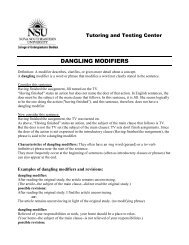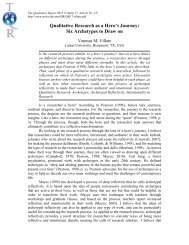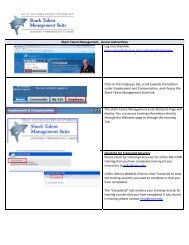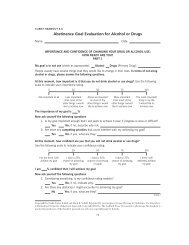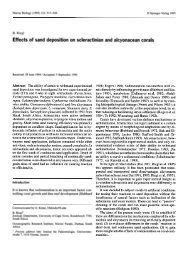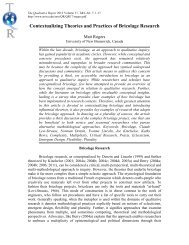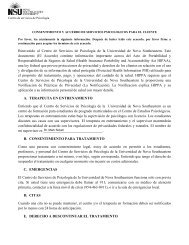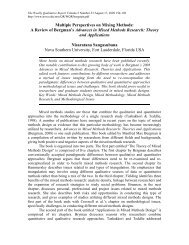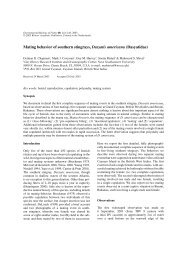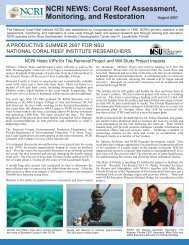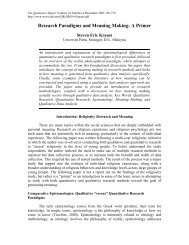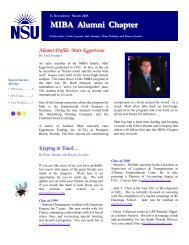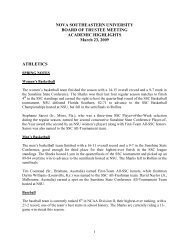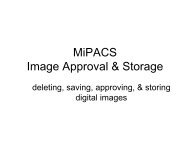11th ICRS Abstract book - Nova Southeastern University
11th ICRS Abstract book - Nova Southeastern University
11th ICRS Abstract book - Nova Southeastern University
You also want an ePaper? Increase the reach of your titles
YUMPU automatically turns print PDFs into web optimized ePapers that Google loves.
23.1039<br />
Effectiveness Of A Small Mpa in Conserving Fish Resources<br />
Victor NESTOR* 1 , Charlene MERSAI 1 , Geory MEREB 1 , Yimnang GOLBUU 1<br />
1 Research, Palau International Coral Reef Center, Koror, Palau<br />
While there has been a proliferation of MPA establishment in Palau, little effort has been<br />
directed at evaluation of these MPAs' management and impacts. We evaluated whether a<br />
small 1 km2 MPA can be effective in conserving fish resources. Underwater surveys<br />
were carried out to obtain fish abundance, hard coral cover and rugosity in Ngelukes<br />
Conservation Area and Uedangel, its control site. Fish abundance in Ngelukes CA<br />
increased from a 48.9 ± 7.8 (Mean ± SE) in 2005 to 69.7 ± 25.0 and decreased to 53 ±<br />
14.1 in 2007. For the control site, Uedangel, there was a different pattern with a<br />
consistent decrease in fish abundance over the three-year period. Fish abundance was<br />
35.3 ± 7.2 (Mean ± SE) in 2005 and decreased to 28.1 ± 7.3 in 2006 and by 2007 the fish<br />
abundance was 27.1 ± 7.9. This fluctuation in fish abundance inside Ngelukes CA and<br />
the decrease in Uedangel from 2005-2007 were not significant so data for the different<br />
years were pooled. Analysis of the pooled data showed that there was a significant<br />
difference in the number of fish inside Ngelukes CA compared to its control site with<br />
mean fish abundance in Ngelukes at 57.2 ± 10.5 (Mean ± SE) compared with the control<br />
site, which only had a mean fish abundance of 30.2 ± 4.3. There was no significant<br />
difference in coral cover and rugosity between Ngelukes CA and its control site. Since<br />
there was no difference between rugosity and coral cover between the MPA and its<br />
control site, the differences in fish abundance between the MPA and control is more<br />
likely due to protection, rather than the type of habitat it has. The results of this study<br />
showed that even small MPAs could still be effective in conserving valuable resources.<br />
23.1040<br />
Species Composition And Abundance At Two Protected Spawning Aggregation<br />
Sites In Palau With Different Length Of Closure<br />
Geory MEREB* 1 , Arius MEREP 1 , Alan FRIEDLANDER 2 , Yimnang GOLBUU 1<br />
1 2<br />
Palau International Coral Reef Center, Koror, Palau, NOAA/NOS/CCMA-<br />
Biogeography Team, Waimanalo, HI<br />
Grouper spawning aggregations are heavily targeted around the world. In Palau,<br />
Ngerumekaol and Ebiil Channels are both spawning aggregation sites that have been<br />
protected from fishing since 1976 and 2000, respectively. Groupers and other resource<br />
species were monitored monthly over a 1.5-year period at these two protected spawning<br />
aggregations and two nearby control areas. Surveys were conducted 2-6 days before the<br />
new moon of each month, which coincides with the peak aggregation period in Palau. At<br />
the aggregation sites, three grouper species (Plectropomus areolatus, Epinephelus<br />
polyphekadion, and E. fuscoguttatus) accounted for 78% of the number and 85% of the<br />
biomass of all resource species surveyed but comprised < 1% of the total number and<br />
biomass at control sites. Number and biomass of the three major grouper species pooled<br />
was significantly higher at Ngerumekaol compared to Ebiil. Plectropomus areolatus was<br />
the dominant grouper at both spawning sites and numbers, biomass, and size were all<br />
higher at Ngerumekaol compared to Ebiil. The larger Epinephelus fuscoguttatus ,<br />
showed even more pronounced differences between the two sites with higher values also<br />
at Ngerumekaol. Epinephelus polyphekadion was the third most important species at<br />
Ngerumekaol but only one individual was encountered at Ebiil. Differences in densities<br />
and composition of grouper species at these two aggregations may be attributed to the<br />
differences in time since closure (Ngerumekaol = 31 years, Ebiil = 7 years). In addition,<br />
Ebiil is further from the capitol, Koror, and experiences problems with poaching. The<br />
peak spawning period at Ebiil occurs during the national open season for groupers and is<br />
therefore easier for poached fish to be sold. The lower numbers of E.fuscoguttatus and<br />
the near absence of E. polyphekadion at Ebiil may reflect the effects of previous and<br />
current overexploitation.<br />
Poster Mini-Symposium 23: Reef Management<br />
23.1041<br />
Learning From The Development Of Marine Protected Area Networks: Is Science Or<br />
Practical Realities The Guiding Force?<br />
Stuart GREEN* 1 , Alan WHITE 2 , Stacey KILARSKI 2 , Patrick CHRISTIE 3 , Anna MENESES 4 ,<br />
Leah BUNCE 5 , Giselle SAMONTE-TAN 5 , Kate NEWMAN 6 , Stuart CAMPBELL 7 , Helen<br />
FOX 6<br />
1 TNC, Tagbilaran City, Philippines, 2 TNC, Honolulu, HI, 3 <strong>University</strong> of Washington,<br />
Washington, WA, 4 TNC, Manila, Philippines, 5 CI, Washington, WA, 6 WWF, Washington, WA,<br />
7 WCS, Bogor, Indonesia<br />
Marine protected areas (MPAs) and networks of MPAs are an accepted means of protecting<br />
coral reef and associated habitats and enhancing near-shore fisheries. A growing number of<br />
MPA networks are being formed to provide important spatial links needed to maintain<br />
ecosystem processes and connectivity, as well as improve resilience by spreading risk in the<br />
case of localized disasters, failures in management or other hazards, and thus help to ensure the<br />
long-term sustainability of populations This study is part of the “Marine Learning Partnership”<br />
among four global non-government organizations engaged in the development of MPA<br />
networks in Indonesia, Papua New Guinea and the Philippines. The primary objective of the<br />
study was to assess the status of the MPA networks in varying stages of planning and<br />
implementation, identify major gaps in information, science, knowledge, and enabling<br />
conditions, and to generate and disseminate increased knowledge of MPA networks through<br />
collaboration. Methodology of the study included: field observation at six sites,<br />
implementation of a structured interview protocol that engaged the MPA managers and primary<br />
stakeholders at the field sites and in national offices, and a stakeholder learning workshop.<br />
Findings show that the six MPA networks are progressing towards their biodiversity<br />
conservation and fisheries management goals. To achieve measureable objectives of effective<br />
habitat protection and connectivity among the individual MPAs, MPA managers and<br />
stakeholders at the sites are discovering that there are many social and governance factors that<br />
must be addressed. The planning for each network is benefitting from improved science and<br />
practical guidance on how to build representative and resilient networks that will minimize loss<br />
from multiple local and global forces over time. Nevertheless, effective management of<br />
individual MPAs and networks is only beginning.<br />
23.1042<br />
Effective Socio-Political Strategies That Help Support Ecological Resilience Of Marine<br />
Protected Area Networks Within The Coral Triangle<br />
Anna MENESES* 1 , Alan WHITE 2 , Stuart GREEN 3 , Stacey KILARSKI 4 , Patrick CHRISTIE 5<br />
1 Global Marine Initiative, The Nature Conservancy, Calamba City, Laguna, Philippines,<br />
2 Global Marine Initiative, The Nature Conservancy, Kailua, HI, 3 Global Marine Initiative, The<br />
Nature Conservancy, Tagbilaran City, Bohol, Philippines, 4 Global Marine Initiative, The Nature<br />
Conservancy, Honolulu, HI, 5 School of Marine Affairs and Jackson School of International<br />
Studies, <strong>University</strong> of Washington, Seattle, WA<br />
The Coral Triangle is the global center of marine biodiversity and one of the world’s top<br />
priorities for conservation. Various organizations and partner groups are working to establish<br />
networks of Marine Protected Area (MPAs) within the Coral Triangle. Network designs are<br />
generally based on scientific principles of resilience, whereby focus is based on reefs that are<br />
most likely to survive threats. Criteria to form networks include among others: (1) protecting a<br />
representative range of habitat types and replicating these at multiple locations to spread the risk<br />
of habitat loss; (2) protecting coral communities that are resistant to bleaching; (3)<br />
understanding coral reef connectivity to other ecosystems and processes, and; (4) increasing<br />
management effectiveness of controllable/human factors. In this light, the “Marine Learning<br />
Partnership” Project (LMPP), involving four global NGOs, is working towards a framework for<br />
tropical marine conservation that emphasizes resilient and representative MPA networks. The<br />
objective of LMPP is to improve conservation field practice in scaling up from MPA sites to<br />
ecological networks, by generating and disseminating knowledge through inter-organizational<br />
collaboration. This required capturing and analyzing experiences gained among institutions<br />
working in six sites across countries through: (1) a survey using standard forms targeting MPA<br />
managers and primary stakeholders, and; (2) a stakeholder learning workshop involving<br />
representatives from participating countries. Since, ecological networking is relatively new,<br />
LMPP sites serve as “reality laboratories”. We are realizing that certain initial socio-political<br />
arrangements are needed to support and sustain MPA network initiatives to achieve ecological<br />
resilience and economic benefits. The most effective socio-political approach taken by each of<br />
the six study sites will be presented to serve as models for others to learn from, considering<br />
various political set-ups and cultures across countries.<br />
496



